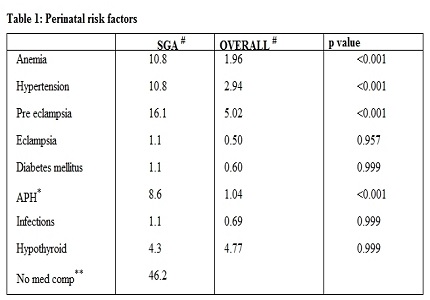Maternal risk factors associated with intrauterine growth restriction: hospital based study
Abstract
Objective: To study the maternal risk factors of intrauterine growth restriction.
Methods: A retrospective analysis was done at a tertiary care Hospital. Ninety three inborn intrauterine growth restriction cases were selected and data was collected by perusal of antenatal records. Intrauterine growth restriction was defined as occurring if birth weight of the newborn is below 10th percentile for gestational age on the intrauterine growth curve based on Fenton’s charts.
Results: Mean age of the mothers included in the study was 20.2 ± 2.857 years. Forty four (47.3%) were born to primipara and 49 (52.7%) to multigravida. Younger maternal age, multiparity were found to be the significant socio-demographic factors associated with Intrauterine growth restriction while, pre eclampsia, chronic hypertension and anemia were the maternal biological factors found to be significantly associated on bivariate analysis.
Conclusions: Younger age, multigravida and chronic medical illnesses are the main risk factors in this hospital based population. Inclusion of prenatal education and screening for medical disorders in antenatal care guidelines will help in curtailing the incidence of IUGR.
Downloads
References
Gluckman PD, Pinal CS. Regulation of fetal growth by the somatotrophic axis. J Nutr. 2003 May; 133(5 Suppl 2): 1741S-1746S.doi: https://doi.org/10.1093/jn/133.5.1741s.
Shrimpton R, Victora CG, de Onis M, Lima RC, Blossner M, Clugston G. Worldwide timing of growth faltering: implications for nutritional interventions. Pediatrics. 2001 May;107(5):E75.doi: https://doi.org/10.1542/peds.107.5.e75.
Xue F, Willett WC, Rosner BA, Forman MR, Michels KB. Parental characteristics as predictors of birthweight. Hum Reprod. 2008 Jan;23(1):168-77. Epub 2007 Oct 12.doi: https://doi.org/10.1093/humrep/dem316.
de Onis M, Blossner M, Villar J: Levels and patterns of intrauterine growth retardation in developing countries. Eur J Clin Nutr. 1998 Jan; 52 Suppl 1:S5-15.
Director General World Health Organization: Bridging the gaps. The World Health Report 1995. Available from url http://www.who.int/whr/1995/en/whr95_en.pdf
Antonisamy B, Sivaram M, Richard J, Rao PS. Trends in intra-uterine growth of single live births in southern india. J Trop Pediatr. 1996 Dec;42(6):339-41.doi: https://doi.org/10.1093/tropej/42.6.339.
Pinheiro A, David A, Joseph B. Pregnancy weight gain and its correlation to birth weight. Indian J Med Sci. 2001 May;55(5):266-70.
Jaafari RM, Ahwaz UMS. Intrauterine growth restriction. Available from url http://220.128.112.10/ftp/medical. Accessed on 16-08-2011.
von Beckerath AK, Kollmann M, Rotky-Fast C, Karpf E, Lang U, Klaritsch P. Perinatal complications and long-term neurodevelopmental outcome of infants with intrauterine growth restriction. Am J Obstet Gynecol. 2013 Feb;208(2):130.e1–6. doi: https://doi.org/10.1016/j.ajog.2012.11.014. Epub 2012 Nov 15.
Bernstein IM, Horbar JD, Badger GJ, Ohlsson A, Golan A. Morbidity and mortality among very-low-birth-weight neonates with intrauterine growth restriction. The Vermont Oxford Network. Am J Obstet Gynecol. 2000 Jan;182(1 Pt 1):198–206.doi: https://doi.org/10.1016/s0002-9378(00)70513-8.
Pallotto EK, Kilbride HW. Perinatal outcome and later implications of intrauterine growth restriction. Clin Obstet Gynecol. 2006 Jun;49(2):257–69.doi: https://doi.org/10.1097/00003081-200606000-00008.
Barker DJ. Adult consequences of fetal growth restriction. Clin Obstet Gynecol. 2006 Jun;49(2):270–83.doi: https://doi.org/10.1097/00003081-200606000-00009.
Narang A, Chaudhuri MK, Kumar P. Small for gestational age babies: Indian Scene. Indian J Pediatr. 1997 Mar-Apr;64(2):221-4.
Singh G, Chouhan R, Sidhu K. Maternal factors for low birth weight babies. Medical J Armed Forces India.2009 Jan;65(1):10-2. doi: https://doi.org/10.1016/S0377-1237(09)80045-2. Epub 2011 Jul 21.
Mavlankar DV, Gray RH, Trivedi CR. Risk factors for preterm and term low birthweight in Ahmedabad, India. Int J Epidemiol. 1992 Apr;21(2):263-72.doi: https://doi.org/10.1007/bf02752452.
Acharya D, Nagraj K, Nair NS, Bhat HV. Maternal Determinants of Intrauterine Growth Retardation: A Case Control Study in Udupi District, Karnataka. Ind J Commun Med 2004 Oct-Dec;29(4):181-2.
Lee KS, Ferguson RM, Corpuz M, Gartner LM. Maternal age and incidence of low birth weight at term: a population study. Am J Obstet Gynecol. 1988 Jan;158(1):84–9.doi: https://doi.org/10.1016/0002-9378(88)90783-1.
Aldous MB, Edmonson MB. Maternal age at first childbirth and risk of low birth weight and preterm delivery in Washington State. JAMA. 1993 Dec 1;270(21):2574–7.
Strobino DM, Ensminger ME, Kim YJ, Nanda J. Mechanisms for maternal age differences in birth weight. Am J Epidemiol. 1995 Sep 1;142(5):504–14.doi: https://doi.org/10.1093/oxfordjournals.aje.a117668.
Kramer MS. Determinants of low birth weight: methodological assessment and meta-analysis. Bull World Health Organ. 1987;65(5):663-737.
Ferraz EM, Gray RH, Cunha TM. Determinants of preterm delivery and intrauterine growth retardation in north-east Brazil. Int J Epidemiol. 1990 Mar;19(1):101-8.doi: https://doi.org/10.1093/ije/19.1.101.
Zhu BP, Rolfs RT, Nangle BE, Horan JM. Effect of the interval between pregnancies on perinatal outcomes. N Engl J Med. 1999 Feb 25;340(8):589–94.doi: https://doi.org/10.1056/nejm199902253400801.



 OAI - Open Archives Initiative
OAI - Open Archives Initiative


